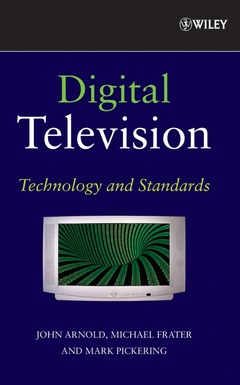Digital Television Technology and Standards

The next few years will see a major revolution in the technology used to deliver television services as the world moves from analog to digital television. Presently, all existing textbooks dealing with analog television standards (NTSC and PAL) are becoming obsolete as the prevalence of digital technology continues to become more widespread. Now, Digital Television: Technology and Standards fills the need for a single, authoritative textbook that covers all aspects of digital television technology.
Divided into three main sections, Digital Television explores:
*
Video: MPEG-2, which is at the heart of all digital video broadcasting services
*
Audio: MPEG-2 Advanced Audio Coding and Dolby AC-3, which will be used internationally in digital video broadcasting systems
*
Systems: MPEG, modulation transmission, forward error correction, datacasting, conditional access, and digital storage media command and control
Complete with tables, illustrations, and figures, this valuable textbook includes problems and laboratories at the end of each chapter and also offers a number of exercises that allow students to implement the various techniques discussed using MATLAB. The authors' coverage of implementation and theory makes this a practical reference for professionals, as well as an indispensable textbook for advanced undergraduates and graduate-level students in electrical engineering and computer science programs.
1. Introduction to Analog and Digital Television.
2. Characteristics of Video Material.
3. Predictive Encoding.
4. Transform Coding.
5. Video Coder Syntax.
6. The MPEG-2 Video Compression Standard.
7. Perceptual Audio Coding.
8. Frequency Analysis and Synthesis.
9. MPEG Audio.
10. Dolby AC-3 Audio.
11. MPEG-2 Systems.
12. DVB Service Information and ATSC Program and System Information Protocol.
13. Digital Television Channel Coding and Modulation.
14. Closed Captioning, Subtitling, and Teletext.
Appendix: MPEG Tables.
Index.
John Arnold, PhD, has been with the University of New South Wales since 1978, most recently at University College, Australian Defence Force Academy, Canberra, Australia. He is currently Professor of Electrical Engineering and Deputy Head of the University College. His research interests lie in the fields of video coding, error resilience of compressed digital video, and coding of remotely sensed data, and he is an Associate Editor of the IEEE Transactions on Circuits and Systems for Video Technology.
Michael Frater, PhD, has been with the University of New South Wales at the Australian Defence Force Academy, Canberra, since 1991, where he is currently an Associate Professor in the School of Information Technology and Electrical Engineering. His research interests include audio-visual communications and communications systems.
Mark Pickering, PhD, is a Senior Lecturer in the School of Information Technology and Electrical Engineering with the University of New South Wales at the Australian Defence Force Academy, Canberra. His research interests include video and audio coding, data compression, information security, data networks, and error-resilient data transmission.
Date de parution : 09-2007
Ouvrage de 648 p.
16.3x24 cm
Mots-clés :
revolution; major; aspects; technology; years; next; digital; prevalence; ntsc; dealing; obsolete; analog; textbooks; single; sections; main; three; audio mpeg; video; heart



